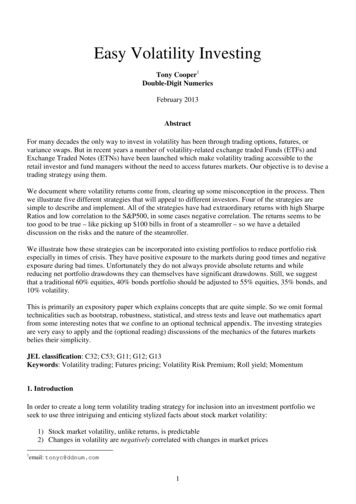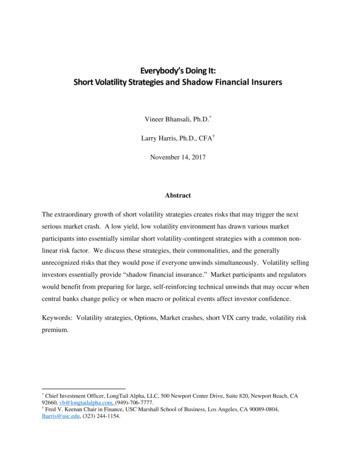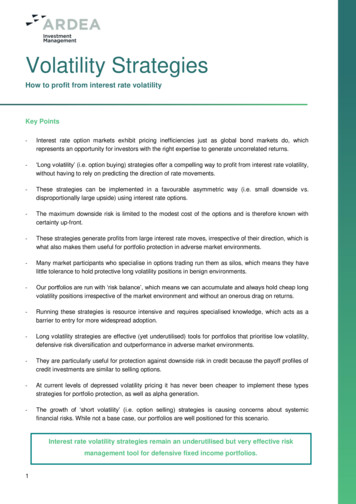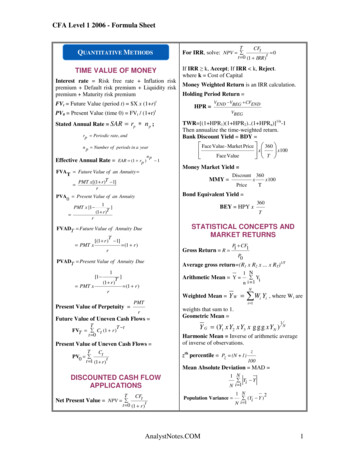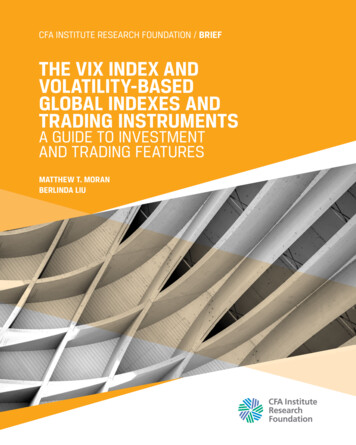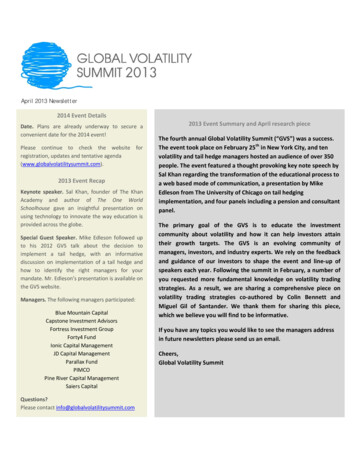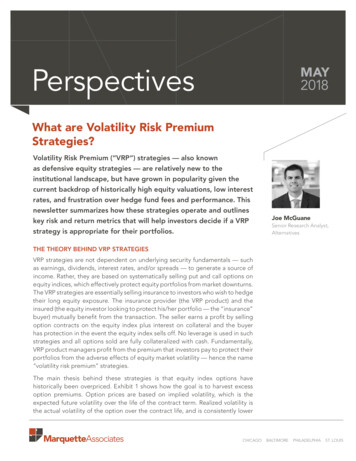
Transcription
PerspectivesMAY2018What are Volatility Risk PremiumStrategies?Volatility Risk Premium (“VRP”) strategies — also knownas defensive equity strategies — are relatively new to theinstitutional landscape, but have grown in popularity given thecurrent backdrop of historically high equity valuations, low interestrates, and frustration over hedge fund fees and performance. Thisnewsletter summarizes how these strategies operate and outlineskey risk and return metrics that will help investors decide if a VRPstrategy is appropriate for their portfolios.Joe McGuaneSenior Research Analyst,AlternativesTHE THEORY BEHIND VRP STRATEGIESVRP strategies are not dependent on underlying security fundamentals — suchas earnings, dividends, interest rates, and/or spreads — to generate a source ofincome. Rather, they are based on systematically selling put and call options onequity indices, which effectively protect equity portfolios from market downturns.The VRP strategies are essentially selling insurance to investors who wish to hedgetheir long equity exposure. The insurance provider (the VRP product) and theinsured (the equity investor looking to protect his/her portfolio — the “insurance”buyer) mutually benefit from the transaction. The seller earns a profit by sellingoption contracts on the equity index plus interest on collateral and the buyerhas protection in the event the equity index sells off. No leverage is used in suchstrategies and all options sold are fully collateralized with cash. Fundamentally,VRP product managers profit from the premium that investors pay to protect theirportfolios from the adverse effects of equity market volatility — hence the name“volatility risk premium” strategies.The main thesis behind these strategies is that equity index options havehistorically been overpriced. Exhibit 1 shows how the goal is to harvest excessoption premiums. Option prices are based on implied volatility, which is theexpected future volatility over the life of the contract term. Realized volatility isthe actual volatility of the option over the contract life, and is consistently lowerCHICAGOBALTIMOREPHILADELPHIAST. LOUIS
than the expected volatility. This difference creates the overpricing gap indicated in the exhibit, and is thepremium collected by the VRP strategy (the insurance seller).Exhibit 1: Overpricing Gap}Overpricing GapSubsequentRealizedVolatilityImpliedVolatilityTo put some data behind this theory, Exhibit 2 looks at the implied volatility minus the realized volatility of theS&P 500 Index over the last 20 years; implied volatility is based off the Chicago Board of Options Exchange(“CBOE”) Volatility Index (“VIX”). The VIX measures market expectations of near-term volatility conveyed byS&P 500 stock index options prices. VIX estimates the expected volatility of the S&P 500 by averaging theweighted prices of 30-day SPX 1 put and calls over a wide range of strike prices. An implied volatility higherthan realized volatility means that selling an option was a profitable transaction. The chart examines theaverage annual implied vs. realized volatility of the S&P 500 over the last 20 years. 19 of those years sawimplied volatility greater than realized volatility, resulting in positive premium collection.Exhibit 2: Implied Volatility Consistently Exceeds Realized 3.34.53.54.43.11.91.81-1-3-2.5-5Average Overpricing Gap Per YearAverage Overpricing GapSource: Bloomberg and CBOE2
RISK AND RETURN CHARACTERISTICSThe CBOE created indices going back to the mid-1990s that track the performance of VRP strategies. TheCBOE S&P 500 PutWrite (“PUT”) Index tracks the performance of selling fully collateralized SPX options. Thestrategy sells a sequence of one-month at-the-money2 S&P 500 Index put options and invests the premiumsin one- and three-month Treasury bills. The CBOE COMBO (“COMBO”) Index tracks the performance ofselling an equal mix of fully collateralized S&P 500 put and call options. It sells a monthly at-the-moneySPX option and a monthly 2% out-of-the-money3 (“OTM”) SPX call option. The short SPX put position iscollateralized by a money market account invested in one-month Treasury bills and the 2% out-of-the-moneySPX call is collateralized by the long SPX index positions.Exhibit 3 illustrates the performance benefits of including options strategies vs. traditionally used indices.Both the PUT and COMBO indices reduce the risk profile of equities (as measured by the S&P 500), whileboosting the returns offered by hedge funds (as measured by the equity hedge index). Investors should notethat VRP strategies will provide better risk adjusted returns over a full market cycle, but performance can varygreatly compared to equity markets, depending on the prevailing market environment.Exhibit 3: Superior Risk and Return ProfileReturn (Trailing Return)10%9%8%7%6%Less RiskHigher Return5%4%3%2%1%0%6%8%10%12%14%16%18%Risk (StDev)CBOE PutWriteCBOE ComboHFRI Equity HedgeS&P 500Source: Bloomberg; data is average annual risk and return for the 10 year period 2008 – 2017VRP PRODUCTSThere is a wide variety of available products from which investors can choose, but it is important to understandthe distinctions behind each VRP fund. We recommend that clients focus on systematic 4 option strategies(as opposed to discretionary5) that are based off the CBOE Combo and PutWrite indices. Such strategies aredesigned to replicate these indices but instead of selling options once a month, they sell options on a weeklybasis, in an effort to outperform their respective indices. These products are institutional quality and can beaccessed through mutual funds or commingled offerings.3
In particular, there are two primary strategies that we recommend to clients. The short strangle6 strategy —shown in Exhibit 4 — is the systematic selling of out-of-the-money put and call options on the S&P 500 Index.The cash collateral is invested 50% in U.S. Treasuries and 50% in the S&P 500 Index. Options are rolled ona weekly basis to improve diversification across strikes, expiration dates and volatility levels, which reducesthe impact of price swings. It does not use leverage and is 100% collateralized. This strategy will sell furtherOTM options when implied volatility is higher. The goal of this product is to outperform the S&P 500 over afull market cycle.Exhibit 4: Short Strangle Strategy 50% ofportfolioin T-bills 50% ofportfolioin S&P500 Index Put andcall optionpremium 0.5% Total ReturnThe second strategy is built around selling at-the-money put options on the S&P 500, and is designedto outperform the CBOE PutWrite Index with lower volatility. This strategy focuses strictly on selling putoptions and assumes that investors will pay a premium for downside protection. Demand is higher for putprotection — due to the long equity exposure most clients have — and allows the strategy to collect morepremiums as well as creating a higher potential return over a full market cycle. This strategy is shown inExhibit 5.Exhibit 5: Selling at-the-money Put OptionsT-bills Put optionpremium 1.5%–Equity drawdown Total ReturnT-bills4
Exhibit 6 shows the performance of the two strategies, with Manager 1 representing the short strangle andManager 2 representing the PutWrite strategy.Exhibit 6: Performance of VRP 31/18)5yrRiskYTDManager 16.2%9.1%16.0%8.4%3.9%8.2%11.7%-2.0%4.7%Manager 2-13.8%12.3%7.8%6.9%8.5%10.7%-4.0%5.0%CBOE E COMBO11.3%7.5%16.5%5.5%4.3%7.9%15.3%-2.1%6.4%HFRI %4.0%16.0%32.4%13.7%1.4%12.0%21.8%-0.8%9.9%S&P 500Given that VRP strategies do not feature 100% long exposure to equity markets, it is not surprising thatthey have underperformed the S&P 500 index during this histroic bull market. However, their volatility isapproximately half of the broad market — so the risk is significantly lower — which is a primary motivation formany investors when moving assets out of equities and into defensive equity strategies. Furthermore, theyhave generally outperformed hedged equity funds, which has contributed to the movement of assets intodefensive equity products.CONCLUSIONVolatility Risk Premium products have evolved into institutional quality products that are a compelling additionto client portfolios. As investors have grown tired of paying hedge fund fees for products that have not livedup to their investment thesis, lower fee VRP strategies have become more attractive. Furthermore, thesesystematic strategies offer a compelling opportunity to diversify institutional portfolios and improve theirrisk/return profile, especially in light of expensive equity markets and growing volatility. Many institutionalinvestors have already added an allocation to these strategies in their portfolios, and we expect this trend tocontinue in the coming years.1S&P 500 index options trade under the symbol SPX and have an underlying value that is equal to the full value of the level of the S&P 500 index2Put or call option strike price is identical to the price of the underlying security3Term used to describe a call or put option that is higher or lower than the market price of the underlying asset4Systematic trading is a rules-based investment process that makes trading decisions in a methodical way5Discretionary trading is decision-based trading, with the trader deciding which trades to make based on the market6Short strangle option strategy requires the investor to simultaneously sell a call and a put on the same underlying security5
PREPARED BY MARQUETTE ASSOCIATES180 North LaSalle St, Ste 3500, Chicago, Illinois 60601CHICAGO I BALTIMORE I PHILADELPHIA I ST. e sources of information used in this report are believed to be reliable. Marquette Associates, Inc. hasnot independently verified all of the information and its accuracy cannot be guaranteed. Opinions, estimates,projections and comments on financial market trends constitute our judgment and are subject to change withoutnotice. References to specific securities are for illustrative purposes only and do not constitute recommendations.Past performance does not guarantee future results.About Marquette AssociatesMarquette Associates is an independent investment consulting firm that guides institutional investment programswith a focused client service approach and careful research. Marquette has served a single mission since 1986 –enable institutions to become more effective investment stewards. Marquette is a completely independent and100% employee-owned consultancy founded with the sole purpose of advising institutions. For more information,please visit www.marquetteassociates.com.6
“volatility risk premium” strategies. The main thesis behind these strategies is that equity index options have historically been overpriced. Exhibit 1 shows how the goal is to harvest excess option premiums. Option prices are based on implied volatility, which is the expected future
